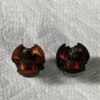I wanted to get a Back-Up #2034-131 armature for my Lionel 520 Boxcab. Before I purchased the back-up unit, I took measurements to make sure that it compared favorably to that of the original armature in the boxcab. All of the measurements were identical as follows:
Overall Shaft Shaft Pinion Pinion
Diameter Length Diameter Teeth Diameter
Original Armature 1" 1.492" 0.125" 10 0.30"
(1 31/64") (1/8") (19/64")
Back-Up Armature 1" 1.492" 0.125" 10 0.30"
When I got home, I measured the resistance between the armature segments:
Original Armature = ~1.4 ohms
Back-Up Armature = ~2.5 ohms
The Back-Up Armature runs fine in the Boxcar. My question is: Will the difference in the segment ohm readings (1.4 vs 2.5 ohms) have any detrimental effect on the Boxcab (i.e e-unit, brushes, etc.) with prolonged use of this Back-Up Armature? I have attached 3 pictures of the 2 armatures for reference.









